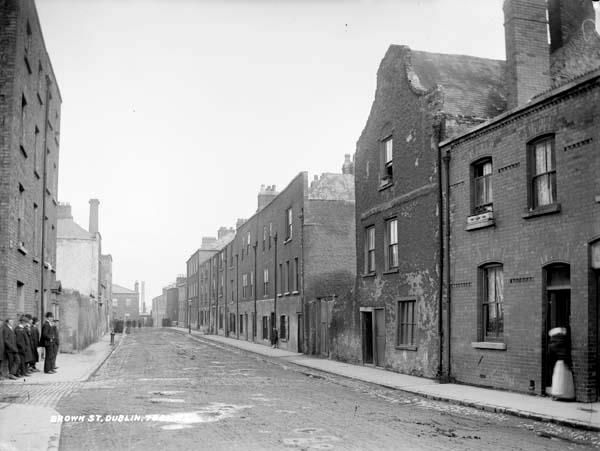“Our cities can never be made really habitable or worthy of an enlightened people while the habitations of its citizens remain the property of private individuals. To permanently remedy the evils of city life the citizens must own their city.” (James Connolly, Workers’ Republic, 18 November 1899)
“The so-called housing shortage, which plays such a great role in the press nowadays, does not consist in the fact that the working class generally lives in bad, overcrowded and unhealthy dwellings. This shortage is not something peculiar to the present; it is not even one of the sufferings peculiar to the modern proletariat in contradistinction to all earlier oppressed classes. On the contrary, all oppressed classes in all periods suffered more or less uniformly from it. In order to make an end of this housing shortage there is only one means: to abolish altogether the exploitation and oppression of the working class by the ruling class.” (Frederick Engels, The Housing Question, 1872)
The South’s cities are in the grip of a housing crisis. With the spread of teleworking, bourgeois forecasters predict that this trend will expand to the larger county towns and internet-connected beauty spots throughout the country.
But why is housing so tied up in the contradictions of the modern Irish republic? To explain this we must turn to Marx, examining his theories of ground rent and fictitious capital. And in examining this issue we must remain aware that Ireland exists in a particular post-colonial situation, and that imported analysis from Britain or elsewhere does not map perfectly onto the material circumstances of the modern Republic.
Housing is unique in that it is a crucial element in the cost of reproduction of labour power—every worker must have a place to live—but yet is too expensive for any worker to buy outright. For the worker, rent is earned in one hat, as worker, but paid in another, that of the commodity consumer. This leads to a circumstance where alternative mechanisms are needed to house workers.
In Ireland, historically, this has taken the form of state-subsidised home-ownership (discussed in detail later), mortgages, and subsidised renting, both private and through social housing. However, the Republic’s social housing model has always been based on a transition to home-ownership, since before independence. It is important to underline this, as it is a crucial distinction between post-independence Ireland and Britain.
Another important factor in the housing equation is the role of the state. An unusual facet of the housing question is that it pits two elements of the bourgeoisie against one another: capitalists and landowners. Landowners own parts of the earth’s surface, something that cannot be increased or produced. The state protects the exclusive right to this property, and it has value solely through this exclusion of others. It becomes a source of income for the owner because others, capitalists or tenants, need premises for business or to live in. The landowner charges a price—rent—for a temporary lifting of this legal barrier.
Here, one part of society demands a tribute from the others for the right to inhabit the earth, just like property in general, the right of owners includes exploiting the earth’s body, the bowels of the earth, the air and thus the maintenance and development of life. (Karl Marx, Capital, vol. 3, p. 782)
This rent is diverted from the profits of the capitalist, being a requirement for production. The state is required to mediate this conflict. High housing rents increase the cost of reproduction of labour power, hurting capitalists; but low rents hit landlords. For this reason, state intervention has been prevalent. However, even beyond mediating that intra-class conflict, the state has directly influenced the housing market through the regulation of standards, planning, by-laws, and indirectly through the regulation of different tenure categories (part 4 tenancies etc.).
What determines the price of rent is the purpose for which it will be used. The land can have some innate characteristics—good arable soil, for instance—but it is the potential that the land-users see in it that defines its price.
There are three categories of ground rent, as Marx defines them: differential rent, absolute rent, and monopoly rent.
It is the land rent capitalized in this way that forms the purchase price or value of the land, a category that is prima facie. . . irrational, since the earth is not the product of labor, and therefore has no value either. On the other hand, behind this irrational form, there is a real relationship of production. (Karl Marx, Capital, vol. 3, p. 636)
Differential rent occurs where there is a variance in the quality of land for production. Capital investment in good, well-drained land provides a better return than the same investment in less good land. This additional surplus value created is the differential, and the landowner charges a portion of it as an extra cost for the use of the land.
Absolute rent is the rent required by the landowner to release previously unused land. With barriers of entry of capital, due to the landowners’ exclusive rights to the land, the landowner can demand some minimum return before providing access to capital improvement of the land. It is the price of land at the margin.
Monopoly rent is where the price is defined purely by supply and demand. There is some unique legal or physical characteristic that makes the land desirable, and the landowner can earn super-normal rents from the requirement of the tenant. Marx uses the example of a vineyard that produces a special vintage. This special property cannot be replicated, and so the rents on this property would be unnaturally high. It is this monopoly rent that we are most concerned with in the housing question, with such factors as zoning, amenities and location making housing a monopoly proposition.
It is the monopoly property of housing that allows the landowner to transform what is a purely rent-earning property into an asset: fictitious capital. The extrapolated value of the asset becomes divorced from its underlying rental value, in pure market terms, as it is now competing against changing interest rates and alternative asset investment. This is due to the monopoly properties allowing the landowner to anticipate the future attractiveness of the property, taking into account the competing speculation on these other variables.
Fictitious capital is the claim on future productive value; and, by treating the land as both a rent-bearing property and an asset, the landowner can use the monopoly provided by his exclusive legal claim to land to claim greater shares of future labour reproduction costs in the form of higher rents.
Thus it is not the competition between tenants for the use of land that is setting prices, as we can see from how far outside of reasonable affordability rent has become in our present situation: it is instead determined by the efficiency with which workers and capitalists can work off the interest demanded by landowners for the release of their land.
The fact that capitalised ground-rent appears as the price or value of land, so that land, therefore, is bought and sold like any other commodity, serves some apologists as a justification for landed property since the buyer pays an equivalent for it, the same as for other commodities; and the major portion of landed property has changed hands in this way . . . To derive a justification for the existence of ground-rent from its sale and purchase means in general to justify its existence by its existence. (Karl Marx, Capital, vol. 3, p. 637)
So, then, how does this apply to the Irish situation?
In the nineteenth century, Irish housing was fairly concordant with the British housing model. In tandem with rapid urbanisation and proletarianisation, infectious diseases began to run rampant in the clustered populations.
Engels wrote in The Housing Question:
Capitalist rule cannot allow itself the pleasure of creating epidemic diseases among the working class with impunity; the consequences fall back on it and the angel of death rages in its ranks as ruthlessly as in the ranks of the workers. As soon as this fact had been scientifically established the philanthropic bourgeois began to compete with one another in noble efforts on behalf of the health of their workers.
This was also the case in Ireland, where the majority of those philanthropic organisations were Protestant social organisations. With the expansion of the franchise, among other concessions won by Irish Catholic nationalists, local authorities in most areas of the South began to be dominated by Catholics who aimed to step in as a counterpoint to Protestant philanthropy. In this way housing policy in Ireland begin to diverge from the British system in the 1900s. One of the characteristics of this new nationalism was a historic compromise with the Catholic petit-bourgeoisie, which saw a highly rural emphasis on housing.
The Irish agricultural system was, until this point, dominated by a small class of mostly Protestant, oftentimes absentee, landlords, while tenant-farmers were largely Catholic. As the conflict between this largely Protestant landed class and the tenant-farmers grew, the British government sponsored a large buy-out of landholdings by the farmer-tenants. One of the consequences of this was generous subsidies to rural county councils to house rural labourers.
The contradictions at play within British imperialism resulted in a distinct rural housing regime emerging in Ireland, where an attempt to placate this rural unrest led to Catholic farmers getting generous grants for housing workers. However, to avoid this decision being interpreted as precedent in Irish cities (or, more importantly, for the British ruling class in British metropolitan areas), they were explicitly and solely rural in character. Between the 1900s and 1930s, between British rule and into the beginnings of Free State rule, a succession of housing legislation (Labourers Acts) and land reform legislation (Land Acts) kept this system distinct from the rules governing urban social housing (Housing of the Working Classes Acts).
The second major spin-off of land reform for social housing—its conversion into a route to home-ownership—emerged in the 1930s, though it took a further three decades to fully mature and percolate through the system. The land reform catalyst for this development occurred in 1933, when, following campaigning by the anti-land annuities campaign, led by Peadar O’Donnell, the government was forced to take action and cut by half the outstanding annuities that farmers were obliged to pay arising from the Land Act settlements.
Complaining about the lack of even-handedness which this concession represented, rural social housing tenants campaigned for a right to buy their dwellings on similar subsidised terms. A government commission set up to examine this issue concluded that “it is scarcely necessary to argue the advantages of ownership” for rural social tenants, “since the freedom and security that go with ownership… we regard as basic and essential in any Christian state that bases social order on justice” (Saorstát Éireann, 1933:23).
It should be noted at this point that this philosophy echoes a passage that Engels quotes, in The Housing Question, from the Spanish newspaper La Emancipación of Madrid (16 March 1872):
The cleverest leaders of the ruling class have always directed their efforts towards increasing the number of small property-owners in order to build an army for themselves against the proletariat.
The bourgeois revolutions of the last century divided up the big estates of the nobility and the church into small properties, just as the Spanish republicans propose to do today with the still existing large estates, and created thereby a class of small landowners which has since become the most reactionary element in society and a permanent hindrance to the revolutionary movement of the urban proletariat. Napoleon III aimed at creating a similar class in the towns by reducing the size of the individual bonds of the public debt, and M. Dollfus and his colleagues sought to stifle all revolutionary spirit in their workers by selling them small dwellings to be paid for in annual installments, and at the same time to chain the workers by this property to the factory in which they work.
The full maturation of this system came with the Housing Act (1966), which unified the urban and rural housing codes and in the process applied the right-to-buy provisions of the rural code to the urban social housing sector. The result was that Irish social tenants enjoyed a universal right to purchase their homes long before their counterparts in Britain.
In urban areas the take-up of this right was limited at first, but it rose dramatically from the mid-1970s, when particularly generous discounts for purchasers were introduced. By the 1980s two-thirds of the dwellings built by local authorities had been sold to tenants, accounting for a quarter of the owner-occupied stock. We had moved from a situation where the ratio of private to public house construction was 1:1 in the 1950s, 50:1 in the 1990s, and 150:1 in the 2000s.
To do justice to the factors leading to the 2008 financial crisis in Ireland would require analysis well beyond the scope of this article, but Conor McCabe’s incredible Sins of the Father (2011) is one of the finest pieces of scholarship available about the historical forces that have built modern Ireland. Suffice it to say that the 2008 financial crisis intensified the factors at play within the housing system as successive governments failed to tackle the underlying structure of the dysfunctional housing model, instead putting it on life support to attempt to nurse it through and prevent too many losses on the part of the Irish developer and landlord class.
The main development to notice after 2008 is the increasing internationalisation of the housing market, with large vulture funds making up an increasing proportion of the ownership of housing and commercial property. If we examine the components of rent discussed earlier we can understand the impact this has on housing prices, as these international funds do not require the same minimum price to make property available to the market. Not relying on the rental income as a primary source of income, they can hold out for a higher absolute rent and consequently earn a higher portion of future surplus value as fictitious capital. This has intensified the transformation of what was still primarily rental properties into “real estate assets,” which are now trained on extracting a greater and greater portion of surplus value in the future.
The intra-bourgeois tensions that are at play are already noticeable. We can see the seemingly bizarre situation of global tech companies in Dublin calling for rent relief—with their bottom line being hit by the cost of reproduction of labour power.
The Irish housing market is now so dysfunctional as to require radical correction. It is for this reason that such measures as cost-rental schemes are simply inadequate, tactically and economically, since a fundamental downward pressure on rents is needed to relieve the level of costs caught up in the maintenance of the current system. The state needs to fundamentally divorce rents from market forces and return it to a manageable relation to actual salaries. It cannot do this by competing on the same terms as REITs, which are expecting returns of many multiples of what cost-rental schemes are offering.
Cost-rental uses the relatively low cost of maintenance of existing housing provided by the scheme to subsidise the investment in future stock through the collection of rents that cover the overall costs of running the scheme. However, as we have clearly outlined, since rents are determined by the dual pressures of the opportunity costs of land use and a prediction of the future cost of labour reproduction, this necessarily runs up against affordability. The Communist Party has previously presented an excellent analysis on the reality of the high costs of cost-rental to tenants in modern Ireland, and this fact cannot be avoided without avoiding large elements of basic Marxist political economy.
A radical retooling of the Irish housing market involves a large investment in replenishing the stock of public housing, with rents tied to income, not market rates—putting sizeable downward pressure on the market as a whole. It is a fiction to suggest that housing can be “self-funded,” as the pressures of capitalist contradiction make this simply impossible.






